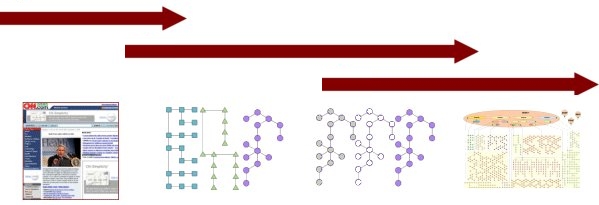 A Technique is Neither a ‘Meme’ nor a Philosophy
A Technique is Neither a ‘Meme’ nor a Philosophy
I have been a participant in an interesting series of discussions recently: Whither goes ‘linked data’?
As I described to someone, I was clearly not a father to the idea of ‘linked data‘, but I was handing out cigars pretty close on to the birth. Chris Bizer and Richard Cyganiak were the innovators that first proposed the original project to the W3C [1]. (Thanks guys!)
From that point forward, now a bit over 2-1/2 years ago, we have seen a massive increase in attention and visibility to the idea of ‘linked data.’ I take a small amount of reflected pride that I helped promote the idea in some way with my early writings.
That visibility was well-deserved. After all, here was the concept:
- Expose your data in an accessible way on the Web
- Use Web identifiers (URIs) as the means to uniquely identify that data
- Use RDF “triples” to describe the relationships between the data.
Much other puffery got layered on to those ideas, but I think those premises are the key basis.
Early Cracks in the Vision
My first personal concern with where linked data was going dealt with an absence of context or conceptual structure for how these new datasets related to one another. I will not repeat those arguments here; simply see many of my blog postings from the past two years or so. Exposing millions of “things” was wonderful, but what did all of that mean? How does one “thing” relate to another “thing”? Are some “things” the same as or similar to other things? If nothing else, these concerns stimulated the genesis of the UMBEL subject concept ontology, an outcome for which I need to thank the community.
It would be petty of me to question the basis that attracted millions of data items to get exposed from linked data techniques. In fact, the richness we have today in exposed Web data objects comes solely from this linked data initiative. But, nonetheless, my guess is that even the most ardent linked data advocate would have a hard time finding a logical way to present the current linked data reality in context. We see the big bubble diagram of available datasets, but, frankly, the position and relationships amongst datasets appears somewhat arbitrary. We have lots of bubbles, but little meaning.
The Constant is Transition
The semantic Web was in serious crisis prior to linked data. It had bad perception, little delivery, and unmet hype. Linked data at least began to show how exposed and properly characterized data can begin to become interconnected.
For a couple of years now I have tried in various posts to present linked data in a broader framework of structured and semantic Web data. I first tried to capture this continuum in a diagram from July 2007:
 |
|||
| Document Web | Structured Web | Semantic Web | |
| Linked Data | |||
|
|
|
|
The point is not whether those earlier characterizations were “correct”, but that linked data be properly seen as merely a natural step in an ongoing transition. IMO, we are progressing nicely along this spectrum.
A Caricature of Itself
Linked data is a set of techniques — nothing more — and certainly not a philosophy or meme (whatever the hell that means). We have way too many breathy pontifications about “linked data this” and “linked data that” that frankly are undercutting the usefulness of the practice and making it a caricature of itself.
In the enterprise world we see similar attempts at marketing that need to give everything a three-letter acronym. In this case, we have a bunch of academics and researchers trying to act like market and business gurus. All it is doing is confusing the marketplace and hurting the practice.
The elevation of techniques or best practices into roles clearly beyond their pay grade produces completely the opposite effect: the idea comes under question and ridicule. The logic and rationale for why we should be following these best practices gets lost in the hyperbole. I spend most of my time hitting the delete button on the mailing lists. I fear what others new to these practices — that is, my company’s customers and prospects — perceive when they look into this topic.
Linked data is useful and needed. But come on, folks, these are not tribal or religious matters.
Declaring Victory, and Moving On
Through the initial project vehicle of DBpedia and then how it nucleated other “linked” data sets, the linked data practice certainly became viral. Today, we have many millions of data items available in linked data form. This is unalloyed goodness.
I will continue to use the phrase ‘linked data’ to refer to those useful techniques noted in the opening. Actually, I think it is best to think of linked data as a set of best practices, but by no means an end unto itself.
Beyond linked data we need context, we need our data to be embedded and related to interoperable ontologies, we need much better user interfaces and attainability, and we need quality in our assertions and use. These are issues that extend well beyond the techniques of linked data and form the next set of challenges in gaining broader acceptance for the semantic Web and the semantic enterprise.
Like most everything else in this world, there are real problems and real needs out there. Thankfully, we have heard mostly the end of the silliness about Web 3.0. Perhaps we can now also broaden our horizons beyond the useful techniques of linked data to tackle the next set of semantic challenges.
So, let me be the first to congratulate the community on a victory well achieved! As for myself and my company, we will now focus our attentions on the next tier of challenges. It is time to deprecate the rhetoric. Huzzah!






Hi Mike – a brilliant post !
Thank you for the balanced view. All too often even a small scucess can spell the end of critical thinking – marketeers just take over and run over the idea killing any possibility of furhter progress.
Mike, great post!
I tend to think today more about the logistics of the information supply chain, from sources (not-so-structured data with not-so-explicit semantics) to end-user interfaces. With linked data technology, we have good conditioning and storing techniques. We have semantic stores, and know how to fill and empty them. Good. Now we have to look at data quality along the supply chain. Let’s focus back a little on the product (the information) rather than the packaging and storage.
Hi!
Congratulations! Your readers have submitted and voted for your blog at The Daily Reviewer. We compiled an exclusive list of the Top 100 semantic web Blogs, and we are glad to let you know that your blog was included! You can see it at http://thedailyreviewer.com/top/semantic-web
You can claim your Top 100 Blogs Award here : http://thedailyreviewer.com/pages/badges/semantic-web
P.S. This is a one-time notice to let you know your blog was included in one of our Top 100 Blog categories. You might get notices if you are listed in two or more categories.
P.P.S. If for some reason you want your blog removed from our list, just send an email to angelina@thedailyreviewer.com with the subject line “REMOVE” and the link to your blog in the body of the message.
Cheers!
Angelina Mizaki
Selection Committee President
The Daily Reviewer
http://thedailyreviewer.com